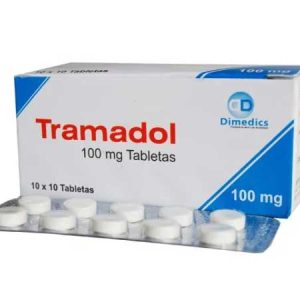Description
OL Tram 100mg is a medication commonly used for the management of moderate to severe pain. The active ingredient in OL Tram is tramadol, a synthetic opioid analgesic. Tramadol has a unique mechanism of action that combines the properties of opioids and non-opioid pain relievers, making it effective for a variety of pain conditions. Tramadol works primarily by binding to opioid receptors in the brain and spinal cord, which helps reduce the perception of pain. Additionally, it inhibits the reuptake of key neurotransmitters, specifically serotonin and norepinephrine, which are involved in pain regulation and mood control. This dual-action mechanism makes tramadol distinct from other opioid analgesics.
The 100 mg dose of OL Tram is often prescribed when lower doses are insufficient for pain control, or when patients require a higher dose to manage chronic or severe pain conditions. This may include pain following surgery, injury, or from chronic pain disorders like osteoarthritis, fibromyalgia, or back pain. It is also sometimes used for conditions that involve nerve pain, such as diabetic neuropathy.
In terms of effectiveness tramadol is typically less potent than stronger opioids like morphine or oxycodone, which can make it a preferred option for managing moderate pain, especially in individuals who may be at risk for opioid addiction or other adverse effects. However, while tramadol is considered less addictive than traditional opioids, it still carries risks, including the potential for dependence, misuse, and overdose, especially when used in high doses or for prolonged periods.
The medication should be taken according to the prescribed dosage, which generally is 100 mg of OL Tram every 4 to 6 hours as needed, with a maximum recommended daily dose of 400 mg. Exceeding this dosage can increase the risk of serious side effects, including respiratory depression, seizures, and overdose. Tramadol has a relatively low potential for respiratory depression compared to stronger opioids but misuse or overdose can still lead to dangerous consequences.
Common side effects of OL Tram 100mg include dizziness, headache, nausea, constipation, dry mouth, and fatigue. Some individuals may also experience mood changes, such as anxiety or irritability. More serious side effects can occur, particularly when tramadol is taken in excess or in combination with other substances. These can include seizures, serotonin syndrome and an increased risk of respiratory depression when used with other central nervous system depressants, such as alcohol or benzodiazepines.
Tramadol is known to carry a risk of addiction, particularly with long-term use. People who have a history of substance use disorder or those who misuse medications are at higher risk for developing dependence on tramadol. Because of this, it is classified as a controlled substance in many countries, including the United States, where it is classified as a Schedule IV drug under the Controlled Substances Act.
The use of OL Tram 100mg should be carefully monitored by a healthcare provider, especially in individuals with a history of seizures, liver or kidney disease, or breathing problems. Tramadol can lower the seizure threshold, making seizures more likely, particularly in individuals with a predisposition to them. It is also important to inform a healthcare provider about any other medications being taken, as tramadol can interact with a variety of drugs, including antidepressants, antipsychotics, and other pain medications, which can increase the risk of side effects.
The drug should be used cautiously in elderly patients, as they may be more susceptible to the sedative effects, dizziness, and other side effects of tramadol. Tramadol should not be used in combination with monoamine oxidase inhibitors (MAOIs) or within 14 days of discontinuing such treatment, as this combination may lead to severe side effects, including hypertensive crisis.
If taken with other drugs that influence serotonin, such as selective serotonin reuptake inhibitors (SSRIs), monoamine oxidase inhibitors (MAOIs), or triptans, there is a risk of serotonin syndrome. Symptoms of this condition include agitation, hallucinations, rapid heart rate, changes in blood pressure, fever, excessive sweating, shivering, muscle spasms, and in severe cases, death.
To prevent overdose, it is crucial that OL Tram 100mg be taken strictly according to a healthcare provider’s instructions. Misuse of tramadol, such as taking it in higher doses than prescribed or using it for non-medical purposes, can lead to significant health risks, including fatal overdose. In cases of suspected overdose, it is important to seek immediate medical attention.
In summary, OL Tram 100mg is an effective option for managing moderate to severe pain, offering both opioid-like effects and additional mechanisms for pain relief. While generally safer than stronger opioids, it still carries a risk of dependence, overdose, and other serious side effects, particularly when not taken as prescribed or when combined with other medications. Regular medical oversight is important to ensure its safe use, and patients should be cautious about potential drug interactions and side effects







Reviews
There are no reviews yet.